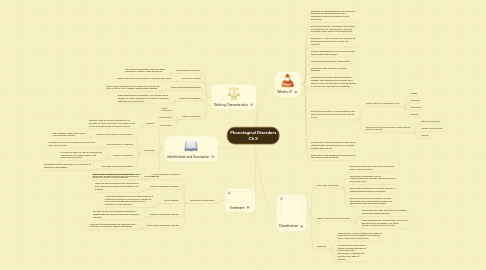
1. Treatment
1.1. Intervention Approaches:
1.1.1. Minimal opposition Contrast Therapy
1.1.1.1. Help children understand the difference between words that are seporated by only one phoneme
1.1.2. Multiple Oppositions Therapy:
1.1.2.1. Helps the child understand the differences in each individual phoneme so that there is less collapse.
1.1.3. Cycles therapy:
1.1.3.1. Continually going over one set of phonemes for a continuous persiod of up to 6 hours a week and onece that time has been reach the set is changed to a new phoneme.
1.1.4. Maximal Oppositions Therapy:
1.1.4.1. Focuses on the more complex phonological targets which will bring out the most change in the child
1.1.5. Phonological Awareness Therapy:
1.1.5.1. Help the child diferenciate and understand the difference is sounds of different phonemes.
2. Identification and Description
2.1. Referral:
2.1.1. typically made by a parent, pediatricain, or educator as they are all able to tell when a child is not using phonological sounds correctly.
2.2. Screening:
2.2.1. Caregiver Interview and Case History:
2.2.1.1. gain a general sense of the childs communication history.
2.2.2. Oral Mechanism Screening:
2.2.2.1. evaluates the function of speech producers and their effectiveness
2.2.3. Hearing Screeening:
2.2.3.1. is a measure taken to rule out that hearling impairments can be the cause of the Phonological disorder
2.2.4. Language screening/evaluation:
2.2.4.1. Evaluates the child's grammar and vocabluary to asses thier intellagability
2.3. Diagnosis:
2.3.1. Taking all the evidence and combining the findings to asees to overall diagnosis.
3. Defining Characteristics
3.1. Small phonetic inventory:
3.1.1. Has a very low phonetic vocabulary when compared to others in their age group
3.2. Phoneme Collapse:
3.2.1. When a child uses one phoneme for multiple phonemes.
3.3. Target-Substitute Relationship:
3.3.1. When a child substitues one phoneme for an other one such as /g/ for /d/ in "doggie" replaced with "goggie".
3.4. Reduced Intelligibility:
3.4.1. When their phoneme inventory is so low that native speakers of their language can not even understand what they are trying to say.
3.5. Special Population:
3.5.1. Down Syndrome
3.5.2. Hearing Loss
3.5.3. Cleft Palate
4. What is it?
4.1. Definition: is and impariment of an individual's phonological system that results in a significant problem with speech-sound production
4.2. Articulation Disorder: emphasizes the impact of the disorder on the individual's ability to articulate certain speech sounds effectivly
4.3. Prevalence: 4-13% of children are affected by a phonological disorder (4 in every 100 children).
4.4. Serface representation: What is produced by the individual: (articulation(
4.5. Underlying representation: (phonology)
4.6. Allophones: the variations of a single phoneme.
4.7. International Phonetic Alphabet: phonetic alphabet that describes and classifies each speech sounds on the basis of how and where it is produced in the speech mechanism.
4.8. Articulatory Phonetics: a classification by the action of and articulator to produce a secific sound.
4.8.1. Vowel: little to no obstuction of air
4.8.1.1. Height
4.8.1.2. frontness
4.8.1.3. Roundness
4.8.1.4. Tension
4.8.2. Consonant: when the airflow is obsturcted to produce a sound
4.8.2.1. Place of articulation
4.8.2.2. Manner of articulation
4.8.2.3. Voicing
4.9. Coarticulation: the clasification of articulatory characteristics and how they vary in context and how they overlap.
4.10. Assimilation: how neighboring sounds take on the sounds of one and other.
5. Classification
5.1. Four major symptoms:
5.1.1. Expressive Phonology: difficulty in producing specific speech sounds
5.1.2. Phonological Awareness: lack of understanding how sounds make up sentences and spoken units.
5.1.3. Phonological Processing: no able to retreive or understand phonological information
5.1.4. Word Learning and Word Retrieval: trouble retrieveing words withing the language and being able to articulate them properly
5.2. Types of Speech-Sound Disorders:
5.2.1. Phonological disorder: difficulty in articulating intellagiable laguage by age 9
5.2.2. Speech Differences: difficulty that occurs after age nine and is a relfection of a natice laguage. Sometimes due to illness
5.3. Subtypes:
5.3.1. Speech Delay: children between the ages of 2 and 9 have a low intelegability and frequent errors in phonolgical production.
5.3.2. Questionable Residual errors: children between the ages of 6 and 9 who have phonological disabilities still resulting after speech therapy.
